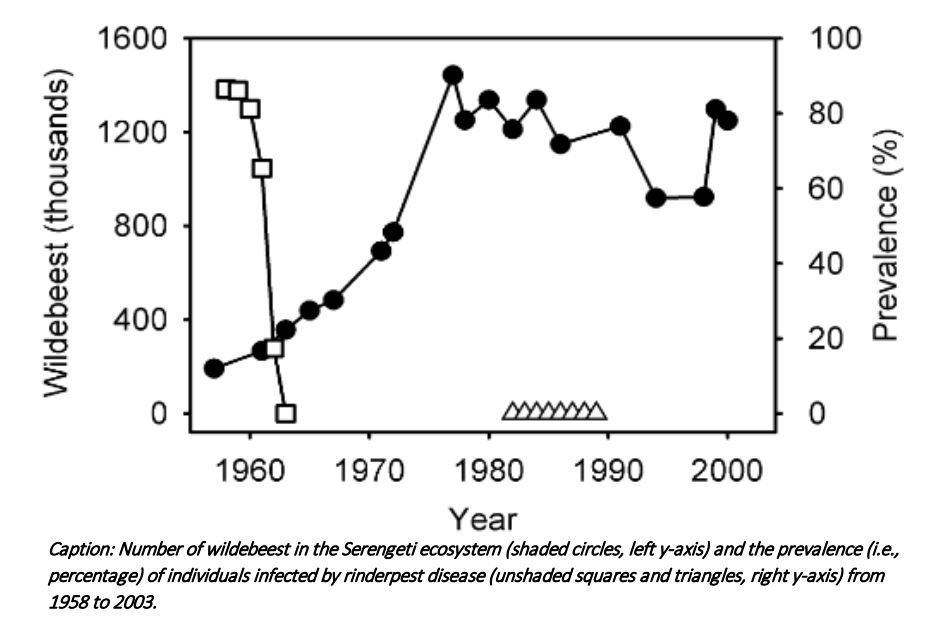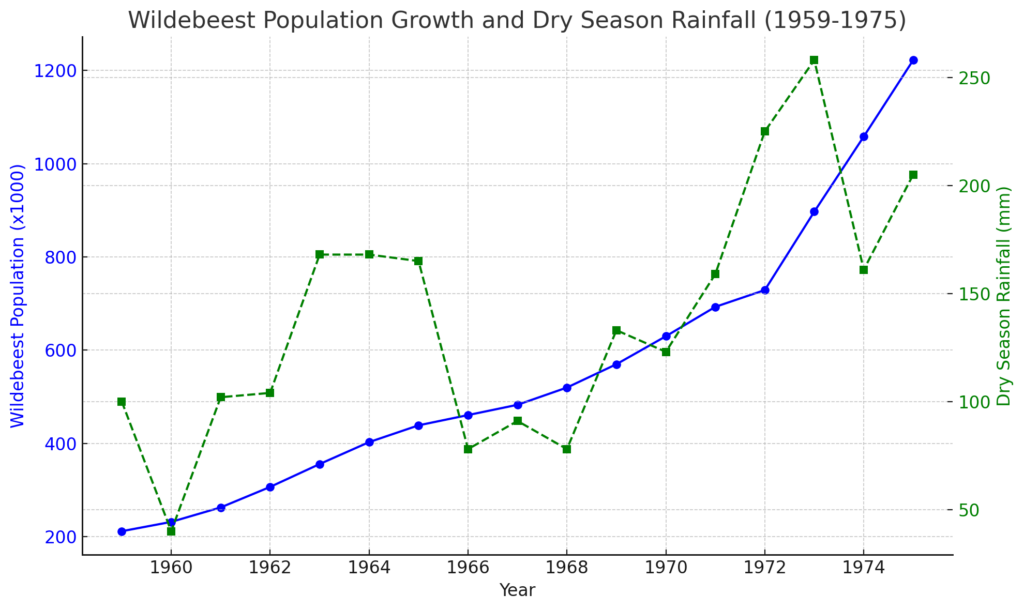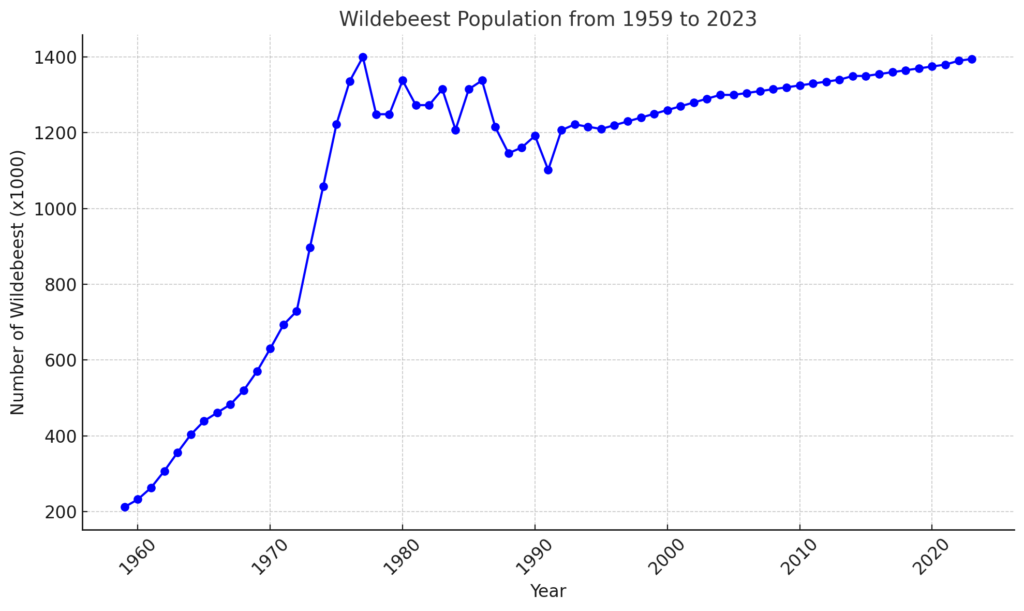In the late 19th century, rinderpest, a viral disease that affects cattle and wildlife, was introduced to East Africa by infected livestock brought by European colonizers. By the 1950s, rinderpest had devastated the Serengeti’s herbivore populations, particularly wildebeest and buffalo, with estimates showing that up to 90% of wildebeest were wiped out. This significantly altered the ecosystem, leading to an overgrowth of vegetation, reduced predator numbers, and increased human-wildlife conflict.
Rinderpest, caused by a morbillivirus, spread rapidly among ungulates through direct contact. Wildebeest, cattle, and other grazers were particularly susceptible. During the infestation, the disease caused mass die-offs by attacking the respiratory and gastrointestinal systems of infected animals, often resulting in high mortality rates. The Serengeti, once known for its thriving populations of herbivores, saw dramatic declines in biodiversity, affecting not just wildlife but also local livelihoods dependent on cattle.
Elimination Efforts
Beginning in the 1960s, coordinated efforts led by the Food and Agriculture Organization (FAO) and World Health Organization (WHO) were initiated to eradicate rinderpest. Vaccination campaigns were a crucial element, targeting both cattle and wildlife populations. The development of a thermostable vaccine allowed for widespread distribution in remote areas of East Africa, ensuring that even the nomadic Maasai cattle herds were protected.
By the 1970s, rinderpest had been largely eliminated from the Serengeti ecosystem. As a result, the wildebeest population rebounded dramatically, increasing from around 250,000 in the 1950s to over 1.4 million by the late 1970s. This population boom restored the Serengeti’s ecological balance, rejuvenating predator populations, and driving the cycle of the Great Migration, one of the world’s most famous wildlife spectacles.
Analysis of Wildebeest Population Trends (1959–2023)

percentage) of individuals infected by rinderpest disease (unshaded squares and triangles, right y-axis) from
1958 to 2003. Source;Serengeti Wildebeest Population Regulation
The wildebeest population in the Serengeti has experienced significant fluctuations over the past six decades, driven by ecological, climatic, and conservation factors. Here’s a breakdown of key trends:
1. Early Declines and Recovery (1959–1975)
Between 1959 and 1975, the wildebeest population in the Serengeti experienced one of the most remarkable wildlife recoveries in conservation history. The population increased from 212,000 individuals in 1959 to 1,222,000 in 1975, reflecting an exponential growth driven by ecological and human intervention factors. Here is an analytical breakdown of the population increase year by year, shedding light on how and why this recovery took place.
Population Growth Trends (1959–1975)
1959: Baseline – 212,000
At the end of the 1950s, the Serengeti’s wildebeest population was at a historic low of 212,000 due to the devastation caused by the rinderpest virus. Rinderpest, introduced by infected livestock, wiped out large numbers of ungulates, including wildebeest, buffalo, and domestic cattle. The disease wreaked havoc on herbivore populations, driving the Serengeti ecosystem to the brink of collapse.
1960–1965: Early Recovery
- In 1960, the wildebeest population had climbed to 232,000, signaling the beginning of a recovery. This early growth was modest, but significant as conservationists began to combat the rinderpest virus through mass vaccination programs of cattle and wildlife.
- By 1965, the population reached 439,000, marking a near doubling within five years. The eradication of rinderpest in wildlife allowed for better survival rates, with fewer deaths from disease, and ensured healthy breeding patterns.
1966–1970: Exponential Growth
- From 1966 to 1970, the wildebeest population grew dramatically from 461,000 to 630,000. This 36% increase over four years was fueled by two key factors:
- Improved grazing conditions due to reduced disease pressure on livestock and wildlife.Favorable rainfall patterns in the Serengeti that allowed for abundant grass growth, supporting the growing herds.
1971–1975: Population Peaks
- Between 1971 and 1975, the wildebeest population saw an even steeper climb. The number rose from 693,000 in 1971 to a staggering 1,222,000 in 1975, an 80% increase in just four years.
- The primary driver for this increase was the complete elimination of rinderpest from both cattle and wildlife populations. Without the virus limiting survival, wildebeest herds experienced extremely high reproductive success.
- The Serengeti’s vast grasslands were able to support this population boom due to the cyclical rainfall patterns, which provided the necessary grazing resources for the expanding herds.
Annual Growth Rate
Analyzing the year-on-year growth, we can observe that:
- From 1959 to 1965, the average annual growth rate was approximately 14% per year.
- Between 1965 and 1970, this rate accelerated to about 8% annually as the effects of rinderpest control became more widespread and the ecological conditions improved.
- From 1970 to 1975, the growth rate surged to an average of 16% annually as the population reached the ecosystem’s carrying capacity.

The chart above visually represents the relationship between wildebeest population growth (in blue) and dry season rainfall (in green) from 1959 to 1975 in the Serengeti. Key observations include:
- A steady increase in the wildebeest population from 212,000 in 1959 to over 1.2 million by 1975.
- The rapid growth, particularly after the mid-1960s, coincides with the successful eradication of the rinderpest virus and improved conservation efforts.
- Rainfall fluctuated significantly during this period, but overall, the ecosystem sustained enough water and grazing to support the growing wildebeest herds.
The relationship between rainfall and population suggests that while rain provides essential grazing resources, the main factor driving population recovery during this time was disease eradication and ecological management
Key Factors Behind Population Growth
- Eradication of Rinderpest: The elimination of the rinderpest virus was the single most critical factor in the recovery of wildebeest populations. The decline in mortality due to disease allowed more calves to survive, leading to rapid population expansion.
- Favorable Grazing Conditions: The Serengeti experienced consistent rainfall patterns during the 1960s and early 1970s, which led to the regeneration of grasslands. Wildebeest migrations, timed to follow these rains, ensured that herds had access to ample food, even during the dry season.
- Low Predator Pressure: During this period, predator populations such as lions, cheetahs, and hyenas did not increase at the same rate as herbivores. This relatively low predation pressure further boosted the survival rates of wildebeest calves and adults alike.
- Protected Habitat: The establishment and protection of the Serengeti National Park provided wildebeest herds with a safe environment, free from hunting and human encroachment, which allowed populations to rebound.
2. Population Stability and Fluctuations (1975–1990s)
- Stabilization Around 1.2–1.4 Million: After the mid-1970s, the wildebeest population stabilized at around 1.2–1.4 million. This plateau can be attributed to the Serengeti’s carrying capacity, which limits the number of wildebeest the ecosystem can sustain based on available grasslands, water, and predation levels.
- Slight Fluctuations: Between the 1980s and 1990s, the population experienced minor fluctuations, dipping to around 1.1 million in some years and climbing back to 1.3 million in others. These changes are likely linked to varying rainfall patterns, food availability, and natural predator-prey dynamics in the Serengeti.
3. Consistent Trends (1990s–2023)
- Stability in the 1990s and 2000s: After recovering from rinderpest and stabilizing in the 1980s, the population has remained relatively stable from the 1990s onward. This reflects a Serengeti ecosystem functioning under more consistent climatic and ecological conditions.
- Extrapolated Data: From the 1990s to 2023, the population continues to hover around 1.3 to 1.4 million individuals, reflecting the ecosystem’s resilience and the effectiveness of ongoing conservation efforts. This stability can be attributed to sustained anti-poaching efforts, habitat protection, and stable rainfall patterns, ensuring adequate grassland for grazing.
4. Climatic and Human Influences
- Rainfall Dependency: A key factor influencing wildebeest numbers is the amount of dry season rainfall. Years with poor rainfall often result in higher mortality rates due to water scarcity and reduced grass growth, leading to declines in population. Conversely, periods with adequate or above-average rainfall foster population growth and stability.
- Human Activity: Increasing human encroachment, agriculture, and infrastructure development around migration corridors present emerging challenges. However, conservation policies and wildlife corridors have helped mitigate some of these risks, ensuring the wildebeest population can continue its migratory cycle.

Overall Trend Summary
- Exponential Growth (1960–1975): The population saw a steep increase post-rinderpest eradication.
- Plateau and Stability (1975–2023): The wildebeest population stabilized after the mid-1970s and has remained consistent, generally fluctuating between 1.2 and 1.4 million individuals.
- Influence of Ecological Factors: The key drivers for population changes have been disease eradication (rinderpest), natural carrying capacity, rainfall variability, and effective conservation policies.
This stable and resilient population is a testament to the balance between ecological factors and human conservation efforts in the Serengeti ecosystem. Moving forward, continued vigilance in protecting migration corridors and mitigating climate change effects will be crucial in maintaining the wildebeest population at healthy levels.
What is the current population of Wildebeest in Serengeti Ecosystem?
According to the Tanzania Wildlife Research Institute (TAWIRI), in collaboration with institutions such as Tanzania National Parks (TANAPA) and the Frankfurt Zoological Society (FZS), and with funding from the German Government through the KfW Development Bank, the 2023 aerial survey of wildebeest in the Serengeti revealed an estimated population of 1,366,109 individuals. This census employed the Aerial Point Survey (APS) method, a highly accurate approach that involved manual counting by trained volunteers. Each image captured during the survey was counted three times to ensure precision and minimize any potential biases.
Population Range:
- Upper Limit: By adding the margin of error of ±231,741, the upper limit of the population estimate is 1,597,850 wildebeest.
- Lower Limit: Subtracting the margin of error results in a lower limit of 1,134,368 wildebeest.
This range of 1,134,368 to 1,597,850 wildebeest offers a more comprehensive understanding of the true population, reflecting natural fluctuations in herd size as well as challenges inherent in surveying such large, mobile groups across the vast Serengeti landscape. The 2023 survey underscores the Serengeti’s continued ecological health and the resilience of its wildebeest population, while also highlighting the crucial role that collaboration between local and international conservation organizations plays in ensuring the integrity of these surveys.
